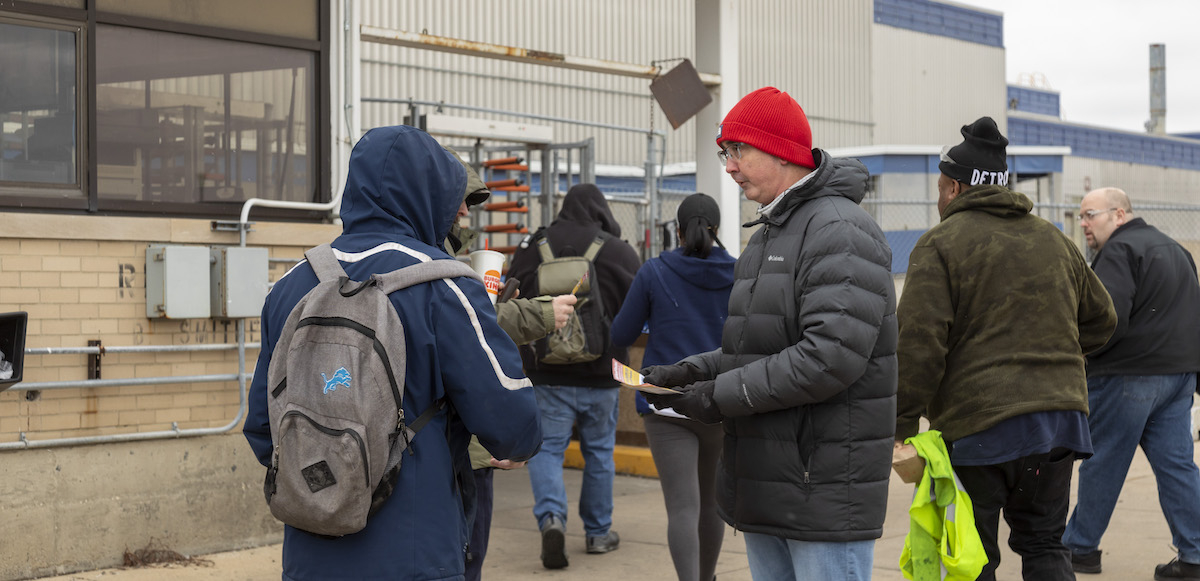Auto Workers Presidential Election a Nail-Biter, Reformers Sweep Regional Races

UAW presidential candidate Shawn Fain campaigned in January at the Faurecia auto parts plant in Saline, Michigan. The election margin is razor-thin as ballots continue to be counted. Photo: Jim West, jimwestphoto.com.
In the first-ever rank-and-file direct election, as opposed to a vote of convention delegates, for the national leadership of the United Auto Workers, the presidential runoff is extremely close, with ballots still being counted. Challenges are expected no matter the outcome.
At stake is the direction of the union. Presidential challenger Shawn Fain and the Members United slate have run on a platform of “No Concessions, No Corruption, No Tiers.” The slate was backed by the reform group Unite All Workers for Democracy (UAWD), which formed in 2019 to fight for members' right to vote on top officers.
Solidarity-wrecking tiers were allowed into contracts by the incumbent Administration Caucus, which ran incumbent Ray Curry for president. AC members were also responsible for one of the biggest union corruption scandals in U.S. history—two former UAW presidents and 14 other union and company officials have faced charges of embezzlement and bribery.
The runoff election comes just six months before the Big Three auto contracts expire, and as the industry undergoes major changes with the rise of electric vehicles and the continued proliferation of non-union automakers and parts manufacturers.
BOARD HANGS IN BALANCE
The runoff election from November’s first round saw three positions up for grabs: the Presidency, the Region 9 (Pennsylvania and Western New York) director, and one of three Vice Presidencies.
Presidential votes are still being counted, but UAW Members United challenger Daniel Vicente has secured the Region 9 director position.
If Fain wins, challengers to the Administration Caucus will hold a majority on the union’s International Executive Board. Members United Secretary-Treasurer candidate Margaret Mock won in the first round, as did four other members of the slate and one independent reformer.

SUPPORT LABOR NOTES
BECOME A MONTHLY DONOR
Give $10 a month or more and get our "Fight the Boss, Build the Union" T-shirt.
Turnout was up around 40 percent from the first round: 141,000 ballots were returned, from the 1 million mailed to 350,000 active members and 650,000 retirees.
The count is likely to come down to the more than 5,000 ballots that have been challenged and thus not counted. Some of these are due to questions over eligibility, which could tie up the results in legal challenges.
According to the federally appointed Election Monitor’s rules, the winners will take office “within seven days of the unofficial announcement of the Run-Off Election winners.” When that announcement will be made—and whether it will be held up by those challenged ballots—is the question.
HOW MEMBERS VOTED
The reformers got support from all sectors of the union, and especially where members have recently been in motion.
The strongest base of support for the incumbent president was Region 1A, which covers some of the Detroit metropolitan area; the big Ford locals were the most favorable to Curry. Local 600, the union’s largest, returned 5,600 ballots; nearly three-quarters of them went for Curry.
But in Chrysler Local 1268, where the company has “idled” the Belvidere Assembly Plant where 1,350 UAW members work (and which supports hundreds more parts suppliers and other operations), workers voted over 70 percent for Fain.
John Deere’s biggest local, Local 838 in Waterloo, where workers repeatedly rejected contracts negotiated by vice presidential contender Chuck Browning, had a similar margin for Fain.
Fain won handily in Region 1D, which covers most of Michigan and includes several General Motors (and GM-supplier) plants in Flint, the Lansing area, and Saginaw. Region 4, covering Illinois, Wisconsin, Iowa, Minnesota, and Missouri, also gave Fain a big lift: he won 57 percent of the 19,838 votes counted. He won the locals covering the GM plants in Kansas City and Wentzville, Missouri.
Although the Administration Caucus machine has won in most Ford Locals, Fain won Ford’s Chicago Assembly plant Local 551, where UAWD leader Scott Houldieson works.
Fain also had a wide majority of support across the higher education sector of the union—scoring 80 percent in Locals 2865 and 5810, academic workers who just led the largest higher education strike in U.S. history at the University of California, and 96 percent among Harvard academic workers in Local 5118.





